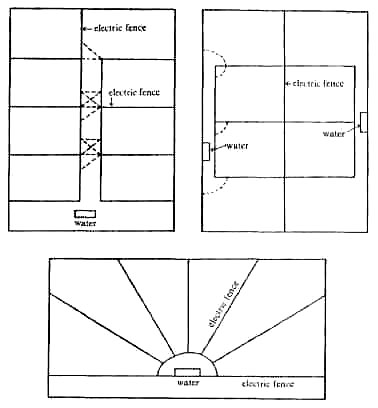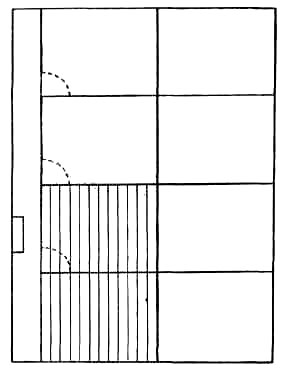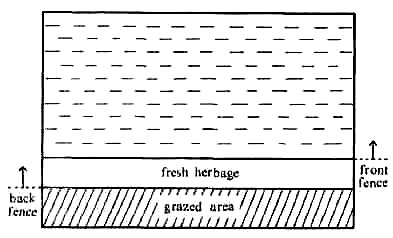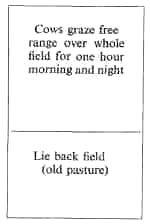ROTATIONAL PADDOCK GRAZING
Variations in Paddock divisions according to position
of water supply

Very few farmers are nowadays so wasteful of their pastures that they allow complete free range for the cattle to wander over the whole of a field. Some kind of controlled grazing is practised by most farmers who grow carefully chosen temporary leys. But there seems to be no concensus of opinion in favour of any particular system.
I've tried many ways of rationing or controlling the grazing of my cattle and am quite sure that completely free range grazing is wasteful and inefficient. What happens when a herd of cows is turned into a field of grass at the optimum stage for grazing? The best of the grazing is finished in three or four days and both quality and quantity of grazing then declines rapidly day by day. The cows have far too much grass, and all the best of the grass during the first day or two of grazing, for they are naturally selective and, unlike a child who saves the almond icing until last, they select the best first. Thereafter they may not have enough, in total quantity, or of the most valuable ingredients. Plants in the hedgerows which are an essential supplement of a simple ley mixture of shallow-rooted ingredients are also quickly eaten down. On the other hand, though more efficient quantity control can be achieved by rationing out the grazing by confining the cows to small sections of the field in rotation, or by allowing them a new strip each day, I would not advocate anything but uncontrolled grazing of simple mixtures if they are to be the sole pasturage. Close confinement on grazing which provides only a few ingredients is the most certain way of ensuring deficiency diseases and bloat, especially where access to the hedgerow herbs is not possible. Cattle which are confined by strip grazing on a small area of a heavily chemicalized growth of one or two shallow rooting grasses and a clover, will ingest large quantities of protein and yield large quantities of milk; but they are certain also to bring large quantities of trouble to the farmer, fees to the veterinary surgeon, and profits to the manufacturers of synthetic trace elements, and magnesium (and other) injections. The top soil of most agriculturally 'progressive' countries is so seriously deficient in the micro-elements of healthy and abundant production that to stimulate high yields, whilst confining the cow to a diet derived only from this inadequate top soil, is financial suicide for the farmer.
Controlled grazing is therefore likely to be trouble-free only if the mixtures used approximate in variety to those advocated in this book. I have, for many years, limited the area upon which my cows graze at any one time, but the variety of their diet, and the depth of mineral, and trace-element-rich subsoil from which it has been derived, have been unlimited. Always, where the complex herbal ley has been used the controlled grazing has been completely trouble free.
The fact that the area of grazing is limited does not mean that the total quantity is inadequate over the grazing period. Indeed the total production of herbage is considerably increased, for, as I have shown earlier, nothing stimulates growth more than grazing or mowing before the flowering stage. Frequent grazing down of young herbage, resting, grazing again, and repeating the process throughout the season, results in anything up to double the yield of herbage that would be obtained by the customary grazing over the whole field of near-mature herbage. What happens is that the cow on controlled grazing actually eats an increased total quantity of higher quality herbage spread evenly day by day over the whole grazing period.
Systems of controlled grazing which I have used are (see diagrams on pages 84-86):
1. The On-and-Off system in which the cattle go into a pasture at the ideal grazing stage for limited periods during the day but are made to lie back to a bare pasture.
2. Rotational Paddock Grazing. Dividing the field into limited areas but allowing the cattle to remain continuously on each paddock until the quality and quantity of herbage is inadequate before moving on to a fresh paddock.
3. Strip-grazing across a whole field by putting an electric fence across a field to provide a restricted strip of grazing, and moving the fence back each day to allow a strip of fresh herbage each day.
4. Strip-grazing of limited paddocks. In this system the field is divided by an electric fence into small paddocks and each paddock is strip-grazed by moving back each day an electric fence across each paddock.
System 4, in theory, makes the most efficient use of the grazing with the least amount of daily labour. The initial length of electric fencing is the greatest by this method and the daily labour is rather less than system 3 as the length of fence to be moved back is less and there is no back fence to be moved. So this could by many be considered the most productive method of utilizing the grazing. But after trying it for a short time I decided that the cattle were too closely confined and the dung deposited seemed to be much more concentrated than by any other method. This resulted in considerable wastage of grazing on the second or third time round the paddocks. By the third grazing such a large proportion of the grass had been soiled by dung that much of the herbage was not acceptable to the cattle. Additionally I could not feel that such close concentration of cattle on a narrow strip of an already limited paddock was a good thing for the health of the cattle—even though a large variety of herbs was included in the mixtures.
I should have no hesitation in condemning this extreme limitation of grazing area on a ley of few ingredients. I have seen much trouble with indigestion, sterility, and worms, where this has been done on the simple ley.
System 1. Obviously the idea of allowing the cow to fill her stomach then lie down, chew the cud and make milk, was a good one. So I practised the on-and-off system for a long time, moving the cows on to an old pasture as soon as the quicker
eaters—usually the better milkers—were satisfied. The sign for the whole herd to be moved was when a few of them started to lie down. About forty-five minutes on a good pasture was usually long enough.
But the disadvantages of this system were: (1) The cattle grew to realize they would be removed from the good pasture to a bare pasture and attempted too quickly to get their fill before being removed.
This resulted in over-eating and bloat. Leisurely eating is essential for a milking cow if she is to make the best use of her food. Rapid stuffing results in indigestion and incomplete utilization of food. Also of the utmost importance is the psychological effect on the cow. The cow who knows she can eat and drink at leisure, as much as she wants, when she wants, and choose her own intervals for lying down and chewing the cud, always makes better use of the food she eats than the cow who is rushed from one place to another, being compelled to grab her food during the limited regulation hours of a man-made schedule.
(2) Labour costs are increased by the need to move the cows from one field to another.
System 3. Strip-grazing across the whole field does not have the same disadvantage of confining the cows to such a limited area as System 4. But this system needs more labour to move a front fence forward to provide fresh grazing, and a back fence behind the cows to prevent the cows from over-grazing the grazed strips and stopping fresh growth.
The maintenance of an ever-ready water supply is a difficulty of this system. A portable water trough with a ball-tap is now available which can be wheeled forward to each fresh strip, but a very long hose is needed to maintain the supply of water from the main.
System 2. Rotational paddocks. This system has proved, in my experience, to be the easiest to operate, and the most efficient in total yield of herbage consistent with the production, health, and comfort of the cow. The field is divided into paddocks providing in each approximately one acre to each ten cows to be grazed. The field remains divided in this way throughout the season so that once the division fences have been erected no futher time is needed for fence moving. All that is needed is for the entrance wire to be moved to allow access to the paddock being grazed whilst leaving a passage to the water-trough but no access to the recently grazed or the fresh forward paddocks.
The ideal method of using this system is to allow young calves and their nurse cows to have first turn in each fresh paddock, followed by the milking herd, and last of all the heifers and dry cows. After the dry cows we top off any ungrazed herbage and let it lie. Whenever possible dung is spread with a flexible-tined scratcher on the tractor hydraulic lift. The reason for preceding the milking herd with the youngest stock is so that they shall get an adequate supply of minerals, trace elements, and vitamins, before any selective grazing has been done by the cows. This provision of best grazing for the calves is most important with pastures of simple mixtures. With a really complex herbal ley it is not so essential.
Alternatively, separate fields may be used for calves as well as dry cows. But it is wise also to divide these fields with the electric fence and essential that the mixture should contain the deep-rooting herbs, so important in laying the foundations of health for the calves.
ROTATIONAL PADDOCK GRAZING
Variations in Paddock divisions according to position
of water supply

No fence moving is required for this system except to open and close each paddock and allow access to water trough
PADDOCK STRIP-GRAZING

Field divided into paddocks, further movable fence placed across the field and moved back each day. No necessity for back fence as cattle move to next paddock when each paddock has been cleared in strips allowing each paddock time to grow before it is needed again

STRIP-GRAZING
Electric fence moved back each day followed by a 'back fence' which keeps the cows from roaming back or continuously grazing the new growth on the grazed area. This allows fresh growth behind the back fence
ON-AND-OFF GRAZING

REARING CALVES ON ROUGHAGE
Calves in my herd live entirely on the fresh green herbage of the herbal ley (apart from the milk which they suckle from the cow), or in winter the silage made from that herbage. No other feeding is given (except an occasional feed of hay when we make it—mostly for experimental purposes only these days—until the heifer comes into the milking herd after calving her first calf. Even then food in addition to pasturage or silage does not exceed 1 lb. per gallon of milk yield.
The calves are turned out with nurse cows as soon after calving as they are settled with the nurse cow. Each calf has a week or ten days with its own dam to give it a really good start. Then it goes to a nurse cow (with one or more other calves) from which it receives 5-7 lb. of milk daily plus silage in winter, or grass, clover, and herbs in summer. The rest of the calf's life is spent out of doors—grazing in summer and self-feeding silage in winter.
I am listing below the names and yields of cows and heifers at present in the herd reared from birth by this method. Their yields, obtained almost entirely on grazing and silage, indicate the efficiency of such a dietary. I am not suggesting that cows reared on substitutes from birth and concentrates from an early age, will, if changed to my natural feeding system, immediately adapt themselves sufficiently to yield milk so efficiently. But there is no doubt about the efficiency of the system of summer grazing and winter self-service feeding, where the animal has been accustomed to it from birth as the following home-bred animals have. These, their current lactations, are a fair sample of the system.
Name
Yield, lb.
Days
Butter Fat %
Calf
Polden Pilot's Pearl
10,250
343
5.50
1st
Polden Chocolate Cake
8,332-1/2
335
5.73
1st
Polden Mogulla's Sultana
9,344-1/2
358
5.78
2nd
Polden Patrician Springtime
8,399-1/2
313
5.17
2nd
Polden Miss Mannin
7,842
283
5.97
2nd
Polden Sunrise
8,860-1/4
331
5.14
3rd
Polden Morning Mist
7,754=1/2
292
5.72
3rd
Polden Sunwise
9,450-1/2
364
5.45
4th
Polden Haughty Hetty
13,140-1/2
364
5.75
7th
Polden Dolly Daydream
13,881
363
5.15
3rd
NEXT